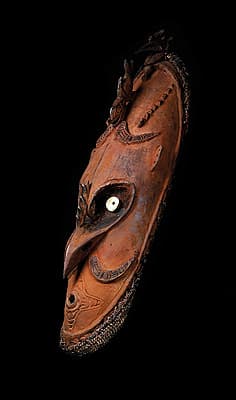
Papua New Guinea, East Sepik Province, Murik Lakes
Gweim 19th Century , wood, ochres, cane, shell110.0 (h) x 30.0 (w) x 26.0 (d) cm On loan from the Papua New Guinea National Museum and Art Gallery
- Personal name Gweim, Gapun village, lower Sepik, Gapun speakers, East Sepik Province.
- Papua New Guinea National Museum and Art Gallery registration number E.16415, plus small mask 80.7.1 attached at the top. Bought by Wayne Heathcote at Mendam village, Murik Lakes. Seized in 1972, donated by Customs in 1974 and registered 24 March 1975. Gazetted as National Cultural Property on 23 December 1971.
- Published in Beier and Aris 1975:22 and Figs 1a-1d; Smidt 1975:52-3 and TPNGPMAG 1974a, Plate opp.p.iv
- Information taken from Barry Craig, 'Living spiritis with fixed abodes', University of Hawaii Press, 2010
This spirit mask with the personal name of Gweim was kept on a wood and cane frame stored in the ceremonial house taab. The mask’s surface shows repeated applications of ochre paint under which is an ancient patina. It was carved without the use of metal tools.
Gweim was created in the early to mid nineteenth century in Gapun village by the carver Wiki, and became notorious for its ability to inflict sickness and death. Such a dangerous spirit is difficult to placate—it was traded out of the community to a man from Mendam village on the Murik Lakes who wanted to gain Gweim’s assistance in avenging the death of his son, who he believed had died of sorcery. Once the mask came to Mendam village Gweim played a more positive role in the beliefs of the community.
This spirit mask with the personal name of Gweim was kept on a wood and cane frame stored in the ceremonial house taab. The mask’s surface shows repeated applications of ochre paint under which is an ancient patina. It was carved without the use of metal tools.
Gweim was created in the early to mid nineteenth century in Gapun village by the carver Wiki, and became notorious for its ability to inflict sickness and death. Such a dangerous spirit is difficult to placate—it was traded out of the community to a man from Mendam village on the Murik Lakes who wanted to gain Gweim’s assistance in avenging the death of his son, who he believed had died of sorcery. Once the mask came to Mendam village Gweim played a more positive role in the beliefs of the community.
This spirit mask with the personal name of Gweim was kept on a wood and cane frame stored in the ceremonial house taab. The mask’s surface shows repeated applications of ochre paint under which is an ancient patina. It was carved without the use of metal tools.
Gweim was created in the early to mid nineteenth century in Gapun village by the carver Wiki, and became notorious for its ability to inflict sickness and death. Such a dangerous spirit is difficult to placate—it was traded out of the community to a man from Mendam village on the Murik Lakes who wanted to gain Gweim’s assistance in avenging the death of his son, who he believed had died of sorcery. Once the mask came to Mendam village Gweim played a more positive role in the beliefs of the community.
